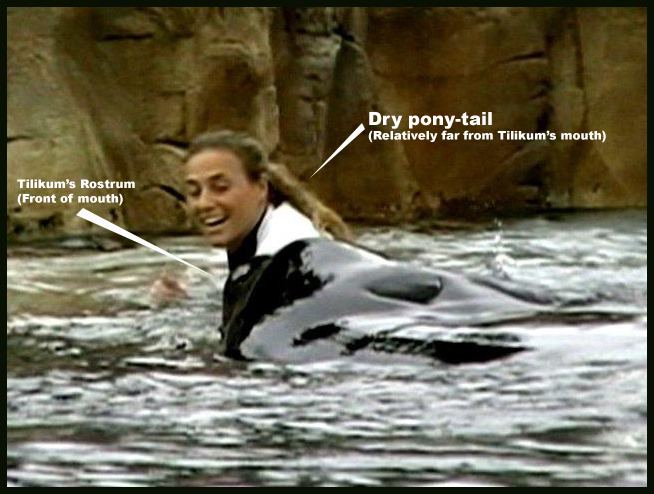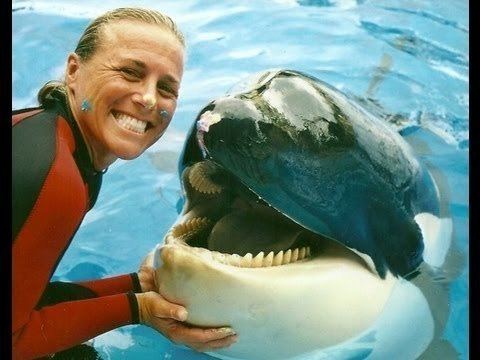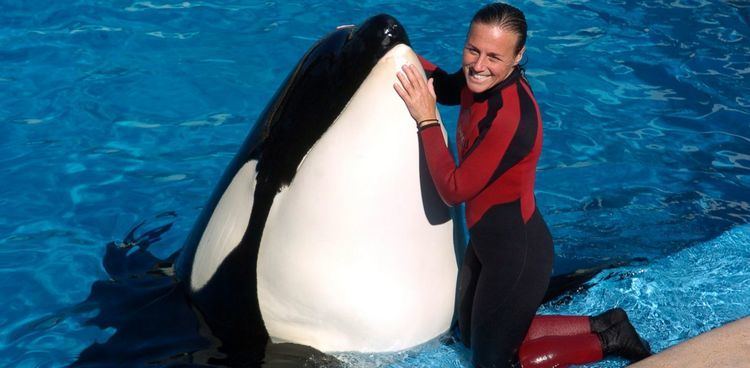Nationality American | Years active 1994–2010 | |
 | ||
Spouse Scott Brancheau (m. 1996–2010) Parents Marion LoVerde, Charles LoVerde Similar Steve Irwin, Timothy Treadwell, Michio Hoshino | ||
Blackfish dawn brancheau
Dawn Therese Brancheau (née LoVerde, April 16, 1969 – February 24, 2010) was a senior animal trainer at SeaWorld. She worked with orcas at SeaWorld Orlando for fifteen years, including a leading role in revamping the Shamu show, and was SeaWorld's poster girl. She was killed by an orca, Tilikum, becoming the only SeaWorld trainer killed by an animal. However, her death was the third fatality associated with Tilikum, and many other trainers have been seriously injured by orcas.
Contents
- Blackfish dawn brancheau
- Trainer dawn brancheau with tilikum at sea world orlando
- Life and career
- Death
- Safety
- Blackfish
- SeaWorld
- Statutory confidentiality
- Foundation
- References

Trainer dawn brancheau with tilikum at sea world orlando
Life and career
Brancheau was born Dawn Therese LoVerde in Cedar Lake, Indiana and was the youngest of six children. She had a passionate love of animals and set her heart on becoming a Shamu trainer during a family vacation to Orlando. She graduated from the University of South Carolina with degrees in psychology and animal behavior. Away from work, she volunteered at a local animal shelter, looked after two chocolate Labradors, and kept a variety of stray ducks, chickens, rabbits, and small birds at her home.

Brancheau spent two years working with dolphins at Six Flags Great Adventure in New Jersey before beginning her career at SeaWorld Orlando in 1994, initially working with otters and sea lions. In 1996, the same year she married Scott Brancheau, a SeaWorld stunt water skier, she started working with orcas.

In 2000, she appeared on CNN affiliate WESH and talked about staying physically fit in order to deal with the intense rigor of working with killer whales. She ran marathons, cycled, and lifted weights to stay in good shape. In 2006, her decade of work with orcas was profiled, including her leadership role in a two- to three-year revamp of the Shamu show. Brancheau acknowledged the dangers of working in close proximity to orcas. As a senior trainer, she appeared in various SeaWorld public performances for many years. The Shamu show's interaction of animal trainers with orcas was regarded as SeaWorld's star attraction.

She was featured on SeaWorld billboards throughout Orlando. Judge Brett Kavanaugh, a dissenting judge in a legal case involving her death (see below), stated that "To be fearless, courageous, tough – to perform a sport or activity at the highest levels of human capacity, even in the face of known physical risk – is among the greatest forms of personal achievement for many who take part in these activities."
Death

On February 24, 2010, Brancheau performed a Dine with Shamu show, with Tilikum, the largest orca at SeaWorld Orlando. In this setting, guests ate at an open-air restaurant while watching the performance poolside as the orca was exercised and fed. As part of the end-of-show routine, she was at the edge of the pool, rubbing Tilikum's head. She was lying with her face next to Tilikum's on a slide-out, which is a platform submerged about a foot into the water. Some sources stated that she was pulled into the water by her ponytail, while others stated that she was pulled into the water by her arm. Witnesses' reports from spectators at the Dine with Shamu Show say that Tillikum grabbed Dawn's arm as she lay in the slide-out area side by side with Tillikum. In any event, the orca's move seems to have been very quick, pulling her underwater and drowning her. At least a dozen patrons witnessed Brancheau in the water with Tilikum. Employees used nets and threw food at Tilikum in an attempt to distract him. Moving from pool to pool in the complex, they eventually directed Tilikum to a smaller, medical pool, where it would be easier to calm him. The orca subsequently released Brancheau's body.
The autopsy report said that Brancheau died from drowning and blunt force trauma. Her spinal cord was severed, and she had sustained fractures to her jawbone, ribs, and a cervical vertebra. Her scalp was completely torn off from her head, her left arm had been ripped off near the shoulder, and her left elbow and left knee had been dislocated.
Safety
No SeaWorld trainer entered a pool to perform a show with an orca following her death. Immediately after her death, SeaWorld disallowed trainers from being in the water with any orca. This internal, voluntary prohibition was similar to what had happened after some other injuries to animal trainers. Each time, the temporary pause was then lifted by SeaWorld. However, on this occasion, the ban was solidified by an Occupational Safety and Health Administration (OSHA) intervention. This led SeaWorld to repeatedly seek the lifting of various aspects of OSHA's citations and rulings until 2014, when it accepted that further attempts to overturn OSHA were not feasible.
Although Brancheau is the only SeaWorld trainer killed by an animal, her death was the third fatality associated with Tilikum and the fourth by a captive orca. Since orcas were first placed in captivity in the 1960s, there have been more than 40 documented safety incidents, with "dozens" of trainers being seriously injured by various orcas. After a 2006 attack, an OSHA investigation in 2007 concluded that, "The continuing factors to the incident, in the simplest of terms, is that swimming with captive orcas is inherently dangerous, and if someone hasn't been killed already, it is only a matter of time before it does happen." SeaWorld successfully challenged the report, which OSHA agreed to withdraw. Additionally, two months before Brancheau's death, another SeaWorld-owned orca, Keto, killed a trainer, Alexis Martínez, at Loro Parque's Orca Ocean in the Canary Islands. Four SeaWorld orcas had been delivered by wide-body cargo plane in February 2006, and SeaWorld staff trained a group of Loro Parque trainers in San Antonio and Orlando. In September 2006, Brancheau had pulled a temporary rotation at Loro Parque and reportedly enjoyed working with Martínez. SeaWorld discontinued water work at its three parks for about a week immediately after Martínez's death.
On August 23, 2010, SeaWorld was fined US$75,000 by OSHA for three safety violations, one directly related to Brancheau's death. OSHA maintained that SeaWorld "willfully" endangered its employees and stated that the company "(shows) Plain indifference to, or intentional disregard for, employee safety and health." SeaWorld issued a statement that called OSHA's findings "unfounded". SeaWorld challenged the OSHA fine and the safety report in legal proceedings, stating that "OSHA's allegations in this citation are unsupported by any evidence or precedent and reflect a fundamental lack of understanding of the safety requirements associated with marine mammal care." At a preliminary hearing in 2011, one of these citations was withdrawn by OSHA. Subsequently, in late May 2012, Judge Ken S. Welsch formally sided with OSHA over SeaWorld's orca safety practices. Welsch was sharply critical of SeaWorld's assertion that it was unaware that working with killer whales posed a hazard to employees. Welsch stated it is "implausible" and "difficult to reconcile" with comments repeatedly made by management and with the litany of trainer incidents and injuries that have occurred over the years. Welsch did, however, agree that the fine classification was too severe and had it downgraded – from "willful" (total of $75,000 for the 2 citations) to "serious" (total of $12,000) – stating that the company had emphasized trainer safety, even if the safety procedures weren't effective.
The court was scathing in its assessment of SeaWorld's expert, Mr. Andrews', opinion, "that Tilikum grabbed Ms. Brancheau by the hair out of curiosity because he was unfamiliar with it" as "speculative" and having "no basis in fact". Accordingly, "The court accords it no weight." The court criticized SeaWorld's "closed system" of logic, which blamed trainers for their injuries, by a flawed circularity of reasoning whereby, "SeaWorld believes it 'condition[s] all aspects of behavior.' All behavior is thus predictable. If an undesirable behavior occurs, it is because the trainer missed a known precursor. Ergo, the trainer is always at fault for the killer whale's undesirable behavior. In this closed system, any injuries sustained by a trainer will always be traceable to human error. It is not the operant conditioning program that is inadequate; it is the performance of the trainer that is flawed." The court made clear that while SeaWorld's expert, "Mr. Andrews concludes his report by stating, 'My expert opinion is that SeaWorld can safely allow trainers to closely interact with killer whales, including waterwork, with the administrative and engineering controls that existed prior to February 24, 2010' (Exh. C-15, p. 10)," the court found otherwise: "As noted in the section addressing the recognized hazard, SeaWorld's own incident reports demonstrate that its safety program, either due to misplaced faith in operant conditioning or due to human error in implementing operant conditioning, exposes its trainers to the risks of death or serious physical injury." The court amplified this, aligning itself with the OSHA expert witness: "Dr. Duffus stated, '[T]he training program that SeaWorld uses is influential. It does work. My point is that it does not work all the time' (Tr. 911). The court agrees with Dr. Duffus. SeaWorld's training program is highly detailed, well-communicated, and intensive. Yet it cannot remove the element of unpredictability inherent in working with killer whales."
Welsch made it clear that his ruling only applies "to the work trainers do during shows and not at other times, such as during medical procedures or 'relationship-building' sessions... As a custodian SeaWorld has an ethical duty to provide for the whales' needs... husbandry activities require a certain amount of contact between the trainers and whales... unlike performances, which can successfully continue without the trainers in the water." OSHA did state that it would accept other means of protection as long as it provided equal or greater safety as the physical barriers. SeaWorld looked at rising pool floors and "spare air" systems in an attempt to get their staff back in the water during shows. Given the court rulings, even after 2010, although water work during shows stopped, SeaWorld trainers still entered the water with orcas during "safety desensitization training" and for other care.
SeaWorld filed a series of appeals, seeking to return to water performances. In 2012, a special Labor Department commission declined to hear the case. Since the Shamu show's interaction of animal trainers with orcas was seen as having been SeaWorld's star attraction, SeaWorld contended that it was fundamental to its business. In April 2014, the US Court of Appeals for the District of Columbia denied a "petition for review". In 2015, SeaWorld was cited again, in San Diego, for not adequately protecting orca trainers.
Although Brancheau's widower, Scott Brancheau, hired a Chicago law firm that specializes in wrongful-death litigation, he has not taken any legal action against SeaWorld.
Blackfish
Brancheau's death is a focus of the documentary Blackfish, which criticizes keeping orcas in captivity, and her death awakened a national conversation about the issue. The director, Gabriela Cowperthwaite, argued that the claim that the orca had targeted Brancheau because she had worn her hair in a long ponytail was conjecture and that "there had to be more to this story".
Her family has said they are grateful that the film has brought attention to the issue of animal welfare. However, they also added that "Blackfish is not Dawn's story" and that "Since Dawn's death in 2010, the media has focused mainly on the whales. A human life was lost that day, and it feels as though some believe her death was just a footnote."
SeaWorld
Brancheau's death has been seen as a factor in starting a trajectory of recalibration for SeaWorld. In addition to the impact of OSHA-imposed safety-based abatements of previous work practices to prevent further similar events, Cowperthwaite began working on Blackfish in 2010 following Brancheau's death, initially having questions about SeaWorld's "ponytail hypothesis". Cowperthwaite's background research suggested to her that there were problems with keeping captive orcas; SeaWorld disagreed, characterizing the film as propaganda. After its release in 2013, the film awakened a national dialogue about the issue. SeaWorld struggled with the effect of Blackfish on public perception, and there were some cancellations by music performers who had planned to hold shows at SeaWorld. SeaWorld transitioned to being a publicly traded company in 2013. Lawmakers in California and the US House of Representatives proposed legislation to phase out orca captivity, and the California Coastal Commission moved in 2015 to ban orca breeding. SeaWorld announced it was discontinuing its program of artificial insemination breeding of captive orcas and was partnering with the Humane Society of the United States to work against commercial whaling and seal hunts, shark finning, and ocean pollution and increase its focus on rescue operations.
Statutory confidentiality
In 2011, Florida passed Statute 406.136, which provides for confidentiality of media obtained by public agencies that depicts or records the killing of a person. The law was partly a response to the circumstances of Brancheau's death. Local government investigators and OSHA had obtained SeaWorld's video surveillance footage, which captured her death, as well as photographs, which showed the effects of the attack. News organizations tried to obtain these media items as records in public custody, but her family expressed privacy considerations and sought to limit "voyeuristic gawking". On behalf of the family, Mills argued in court that disclosure of media by state agencies is equivalent to dissemination, based on the Catsouras case, in which retrospective attempts to limit public access have not been fully successful. The confidentiality considerations turn on issues that resemble those in the case of the death of Meredith Emerson in Georgia; the laws that Georgia and Florida enacted in response to these situations are similar.
Foundation
The Dawn Brancheau Foundation was created by her family in Brancheau's honor.
